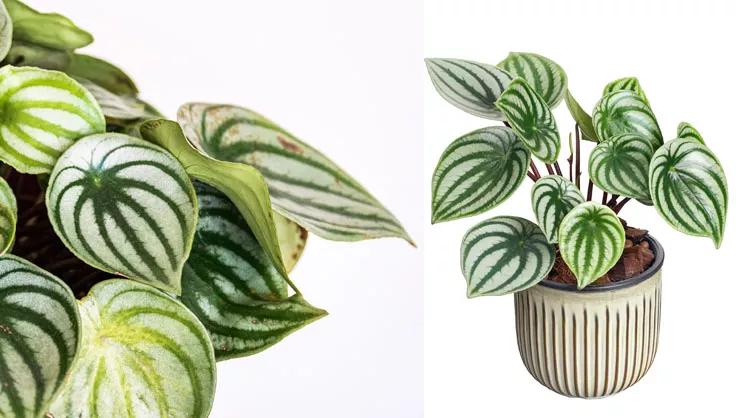How to Care for Watermelon Peperomia

Recommended Types
The standard Watermelon Peperomia is a fantastic choice for its eye-catching foliage. Other Peperomia varieties like Peperomia caperata or Peperomia obtusifolia also offer interesting leaf shapes and textures.
How to Care for Watermelon Peperomia
Caring for Watermelon Peperomia is a joy, as it's not only beautiful but also quite low-maintenance. Here’s your guide to keeping your Watermelon Peperomia happy and healthy
Light
Watermelon Peperomia thrives in bright, indirect light. Too much direct sunlight can fade the colors of the leaves, while too little light can cause them to lose their vibrant patterns.
Soil
A well-draining potting mix is essential. A mixture of regular potting soil with peat and perlite or coarse sand works well to provide the drainage these plants prefer.
Fertilizing
Use a diluted, balanced, water-soluble fertilizer every 3-4 weeks during the growing season (spring and summer).
Watering
Water when the top inch of soil feels dry. Watermelon Peperomia doesn’t like to sit in water, so ensure your pot has good drainage. Overwatering can lead to root rot.
Pruning
Pruning isn’t usually necessary, but you can trim off any leggy stems to encourage bushier growth.
Repotting
Repot every 2-3 years, or when it seems root-bound. Choose a pot that’s slightly larger than the current one.
Propagation
Watermelon Peperomia can be easily propagated by leaf cuttings or by dividing the plant during repotting.
Common Problems with Watermelon Peperomia
Despite being quite hardy, Watermelon Peperomia can encounter a few issues:
Pests and Diseases
Keep an eye out for pests like spider mites and mealybugs. Overwatering can lead to root rot, so be careful with your watering schedule.
Toxicity
One of the great things about Watermelon Peperomia is that it’s non-toxic to pets and humans, making it a safe choice for a household with pets and children.
Watermelon Peperomia FAQs
How can I tell if I'm overwatering my Watermelon Peperomia?
Signs of overwatering include yellowing leaves, a mushy base, or drooping. Let the soil dry out more between waterings.
Can Watermelon Peperomia grow in artificial light?
Yes, it can grow under fluorescent light, making it suitable for offices or rooms without natural sunlight.
Should I mist my Watermelon Peperomia?
While not necessary, misting can help increase humidity, especially in drier environments. However, don’t overdo it as too much moisture can lead to problems.
In conclusion, Watermelon Peperomia is a delightful addition to any indoor plant collection. Its unique, watermelon-like foliage adds a splash of character to your home or office. By following these simple care instructions, you can enjoy the beauty of this plant without much hassle. Whether you're a seasoned gardener or just starting your plant journey, Watermelon Peperomia is sure to bring you joy with its easy-going nature and striking appearance.
Print this Article:
Get the Dirt
Stay up to date on new articles and advice. Please fill out the information below.
